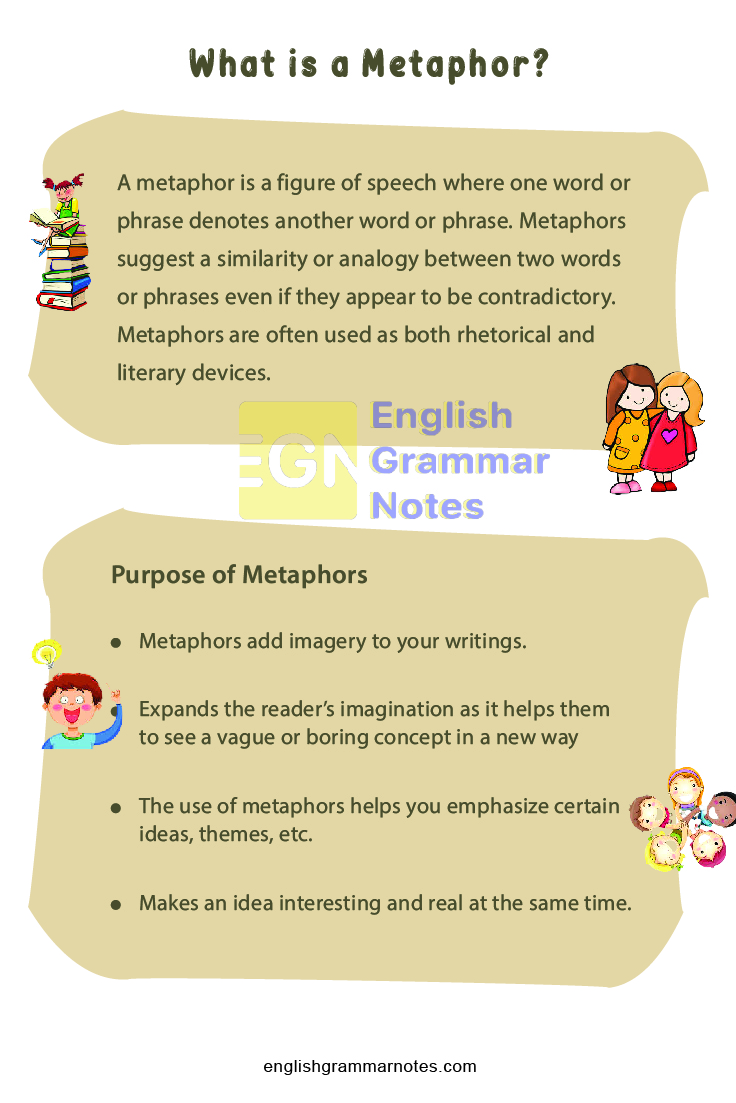Today figurative language has become the norm of even everyday communication. Figurative language adds color and vitality to speech and writing. Metaphor is one such device that has become an inescapable part of everyday conversation as well as literary writing. Hence it is important that you understand exactly how metaphors function. The article will focus on one of the most commonly used figures of speech, metaphor. The article will provide you with a definition of metaphor, its examples, purpose, types, etc.
- What is a Metaphor?
- Types of Metaphors
- Metaphor Examples | List of Metaphors
- Metaphor Vs Simile
- Metaphor Vs Metonymy
- Purpose of Metaphors
- Tips on the Usage of Metaphors
- What is a metaphor?
- Give metaphor examples?
- Distinguish between metaphor and metonymy?
- Why are metaphors used as a literary device?
What is a Metaphor?
A metaphor is a figure of speech where one word or phrase denotes another word or phrase. Metaphors suggest a similarity or analogy between two words or phrases even if they appear to be contradictory. Metaphors are often used as both rhetorical and literary devices.
Types of Metaphors
In this, you will be introduced to the different types of metaphors used commonly.
Common Metaphors: In common metaphors similarities between objects and ideas can be easily understood. These metaphors are also called direct metaphors, primary metaphors, or conventional metaphors. Examples include heart of gold, early bird, etc.
Implied Metaphor: In an implied metaphor, the comparison is not evident directly. These metaphors create vivid imagery.
Extended Metaphor: Extended metaphor is a metaphor that extends for several lines, sentences, or paragraphs. These metaphors can be direct or implied.
Sensory Metaphors: Sensory metaphors are used to appeal to the senses of sight, sound, taste, smell, or touch. Examples include: His sound is music to my ears.
Mixed Metaphor: Mixed metaphor makes use of two contradictory kinds of metaphors. Such a usage often results in an unintentionally comic effect. However, if used intentionally, mixed metaphors can be effective in making a point.
Dead Metaphor: A dead Metaphor refers to a phrase or word that has lost connection with the imagery it is supposed to evoke. This happens due to repeated usage. A dead metaphor is also known as a frozen metaphor or a historical metaphor.
Metaphor Examples | List of Metaphors
Metaphors are everywhere in common speech. Given below is a list of some of the common metaphor examples:
- He’s just blowing off steam.
- That is music to my ears.
- Love is a fine wine.
- She’s a thorn in my side.
- You are the light in my life.
- He has the heart of a lion.
- Am I talking to a brick wall?
- He has ants in his pants.
- Beauty is a fading flower.
- She has a heart of stone.
- Fear is a beast that feeds on attention.
- Life is a journey.
- He’s a late bloomer.
Metaphor Vs Simile
Metaphors are often confused with simile. Both of these are distinct figures of speech. Both of these are used to compare objects or ideas. However, the difference is that simile makes use of words “like” or “as” to create comparisons. Hence similes engage in direct comparisons. Metaphors, on the other hand, imply comparison.
Metaphor Vs Metonymy
You might often get confused with the terms metaphor and metonymy since they sound similar. However, both of these are opposed to each other. While they substitute one thing with another, a metaphor replaces an unrelated term for something, while a metonymy replaces a related term to the original term.
Read More:
Purpose of Metaphors
The use of metaphors is beneficial in several ways. These include:
- Metaphors add imagery to your writings.
- Expands the reader’s imagination as it helps them to see a vague or boring concept in a new way
- The use of metaphors helps you emphasize certain ideas, themes, etc.
- Makes an idea interesting and real at the same time.

Tips on the Usage of Metaphors
The following tips are to be kept in mind, so as to make sure that the metaphor has the required effect.
- The objects compared should have a natural connection
- The use of metaphors should not make your writing complicated
- The use of metaphors should add meaning to what you write.
- Avoid the usage of mixed metaphors as it may lead to confusion.
FAQs on Metaphor
A metaphor is a figure of speech where one word or phrase denotes another word or phrase. Metaphors suggest a similarity or analogy between two words or phrases even if they appear to be contradictory.
Some examples of metaphor include: Love is a fine wine, She’s a thorn in my side, You are the light in my life, He has the heart of a lion, etc
3. Distinguish between metaphor and metonymy?
Metaphor and metonymy are opposite to each other. While they substitute one thing with another, a metaphor replaces an unrelated term for something, while a metonym replaces a related term to the original term.
4. Why are metaphors used as a literary device?
Using metaphors adds imagery to your writings. It expands the reader’s imagination as it helps them to see a vague or boring concept in a new way. Metaphors also make an idea interesting and real at the same time.
Conclusion
When used correctly metaphors can be of great help to you. The use of this figure of speech will surely make your writings entertaining and unique. Concepts can be understood in a more real and simple manner. Metaphors also help you create vivid imagery irrespective of whether it is used in poetry or prose. This will in turn grab the attention of the readers. So make sure to include metaphors and catch the attention of the readers!